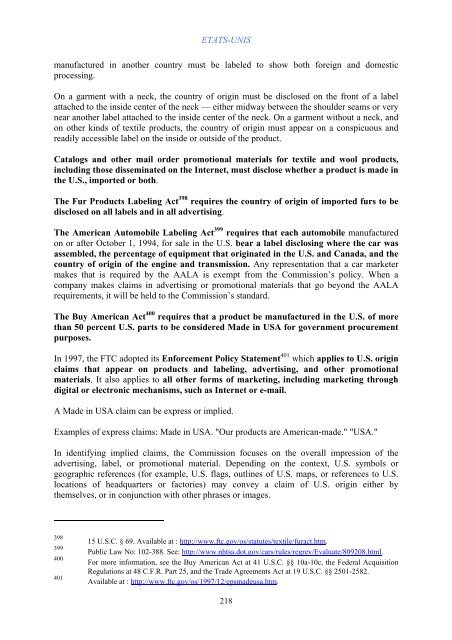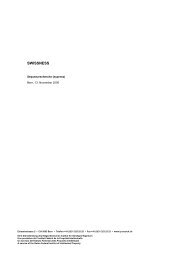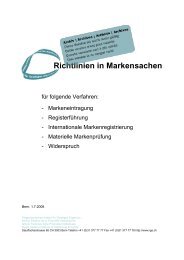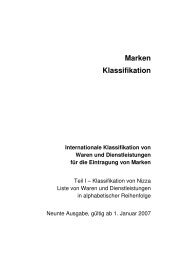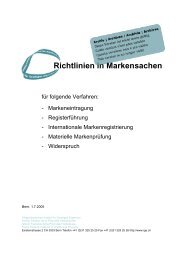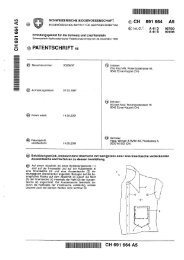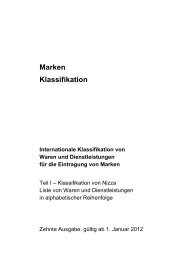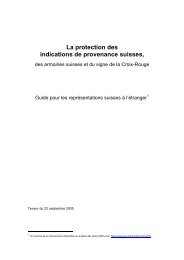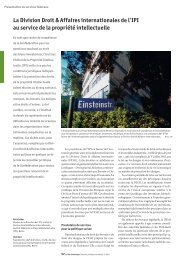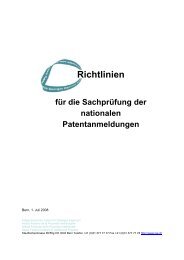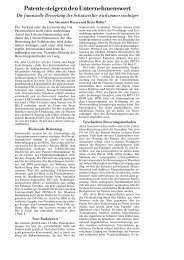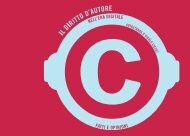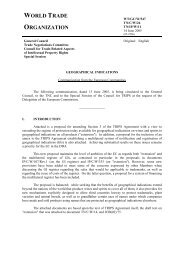AVIS DE DROIT PROTECTION DES SIGNES NATIONAUX
AVIS DE DROIT PROTECTION DES SIGNES NATIONAUX
AVIS DE DROIT PROTECTION DES SIGNES NATIONAUX
Create successful ePaper yourself
Turn your PDF publications into a flip-book with our unique Google optimized e-Paper software.
ETATS-UNIS<br />
manufactured in another country must be labeled to show both foreign and domestic<br />
processing.<br />
On a garment with a neck, the country of origin must be disclosed on the front of a label<br />
attached to the inside center of the neck — either midway between the shoulder seams or very<br />
near another label attached to the inside center of the neck. On a garment without a neck, and<br />
on other kinds of textile products, the country of origin must appear on a conspicuous and<br />
readily accessible label on the inside or outside of the product.<br />
Catalogs and other mail order promotional materials for textile and wool products,<br />
including those disseminated on the Internet, must disclose whether a product is made in<br />
the U.S., imported or both.<br />
The Fur Products Labeling Act 398 requires the country of origin of imported furs to be<br />
disclosed on all labels and in all advertising.<br />
The American Automobile Labeling Act 399 requires that each automobile manufactured<br />
on or after October 1, 1994, for sale in the U.S. bear a label disclosing where the car was<br />
assembled, the percentage of equipment that originated in the U.S. and Canada, and the<br />
country of origin of the engine and transmission. Any representation that a car marketer<br />
makes that is required by the AALA is exempt from the Commission’s policy. When a<br />
company makes claims in advertising or promotional materials that go beyond the AALA<br />
requirements, it will be held to the Commission’s standard.<br />
The Buy American Act 400 requires that a product be manufactured in the U.S. of more<br />
than 50 percent U.S. parts to be considered Made in USA for government procurement<br />
purposes.<br />
In 1997, the FTC adopted its Enforcement Policy Statement 401 which applies to U.S. origin<br />
claims that appear on products and labeling, advertising, and other promotional<br />
materials. It also applies to all other forms of marketing, including marketing through<br />
digital or electronic mechanisms, such as Internet or e-mail.<br />
A Made in USA claim can be express or implied.<br />
Examples of express claims: Made in USA. "Our products are American-made." "USA."<br />
In identifying implied claims, the Commission focuses on the overall impression of the<br />
advertising, label, or promotional material. Depending on the context, U.S. symbols or<br />
geographic references (for example, U.S. flags, outlines of U.S. maps, or references to U.S.<br />
locations of headquarters or factories) may convey a claim of U.S. origin either by<br />
themselves, or in conjunction with other phrases or images.<br />
398 15 U.S.C. § 69. Available at : http://www.ftc.gov/os/statutes/textile/furact.htm.<br />
399 Public Law No: 102-388. See: http://www.nhtsa.dot.gov/cars/rules/regrev/Evaluate/809208.html.<br />
400 For more information, see the Buy American Act at 41 U.S.C. §§ 10a-10c, the Federal Acquisition<br />
Regulations at 48 C.F.R. Part 25, and the Trade Agreements Act at 19 U.S.C. §§ 2501-2582.<br />
401 Available at : http://www.ftc.gov/os/1997/12/epsmadeusa.htm.<br />
218


